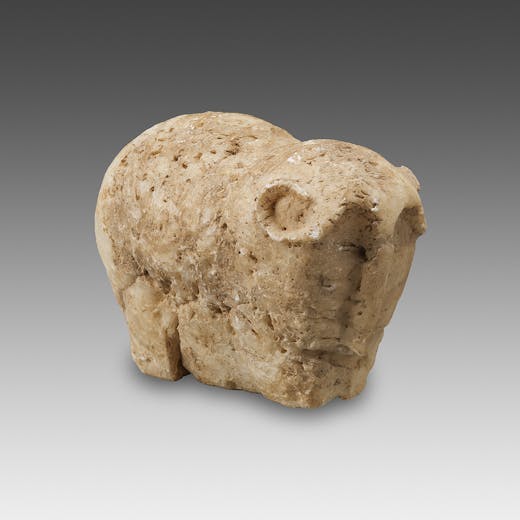Statuette of an Elephant
Near EasternDetailed information of ArtWork
Near Eastern
Statuette of an Elephant
Limestone
H: 7.4 cm
Acquired 1992 on the Swiss art market. Current ownership art dealership, CH. In Switzerland according to the LTBC.
Carved from a small limestone monolith, this statuette is certainly one of the first three-dimensional images of elephant in Near Eastern art; moreover, these large mammals were rarely represented in the rich animal iconography of this prominent culture. While modeled in a simple and somewhat naive way, the body of the animal still attracts the eye of the modern viewer. It was shaped as a cube and not hollowed between the legs, but the well-rounded posterior part clearly depicts the buttocks of an elephant. The opposite end shows more details, which enables us to confidently identify the animal represented here: the eyes (completely pierced), the trunk, the ears and the tusks of the pachyderm are accurately rendered, though in a slightly unrealistic manner. Elephants are known to have existed in Asia and Africa, but elephant bones were also excavated in Near Eastern sites (from the Levant to modern-day Iran): according to some scholars, the existence of a local species would even be possible. Other stone statuettes, especially a very similar figurine housed in the N. Asfar collection, confirm the hypothesis that elephants were present in Mesopotamia during the Neolithic and the Bronze Age (perhaps did they simply arouse curiosity). Furthermore, the Sumerian language included a specific word to define this animal: making a reference to its trunk and to its ability to drag heavy loads, the elephant was referred to as the “ox with hand”. Complete and in good condition, but partially reglued. Minor cracks and gap-fills, superficial wear on the surface.
Unique work
Not signed
Good
Antique
Genève Switzerland
Rue Etienne-Dumont 9, Geneva, Switzerland



